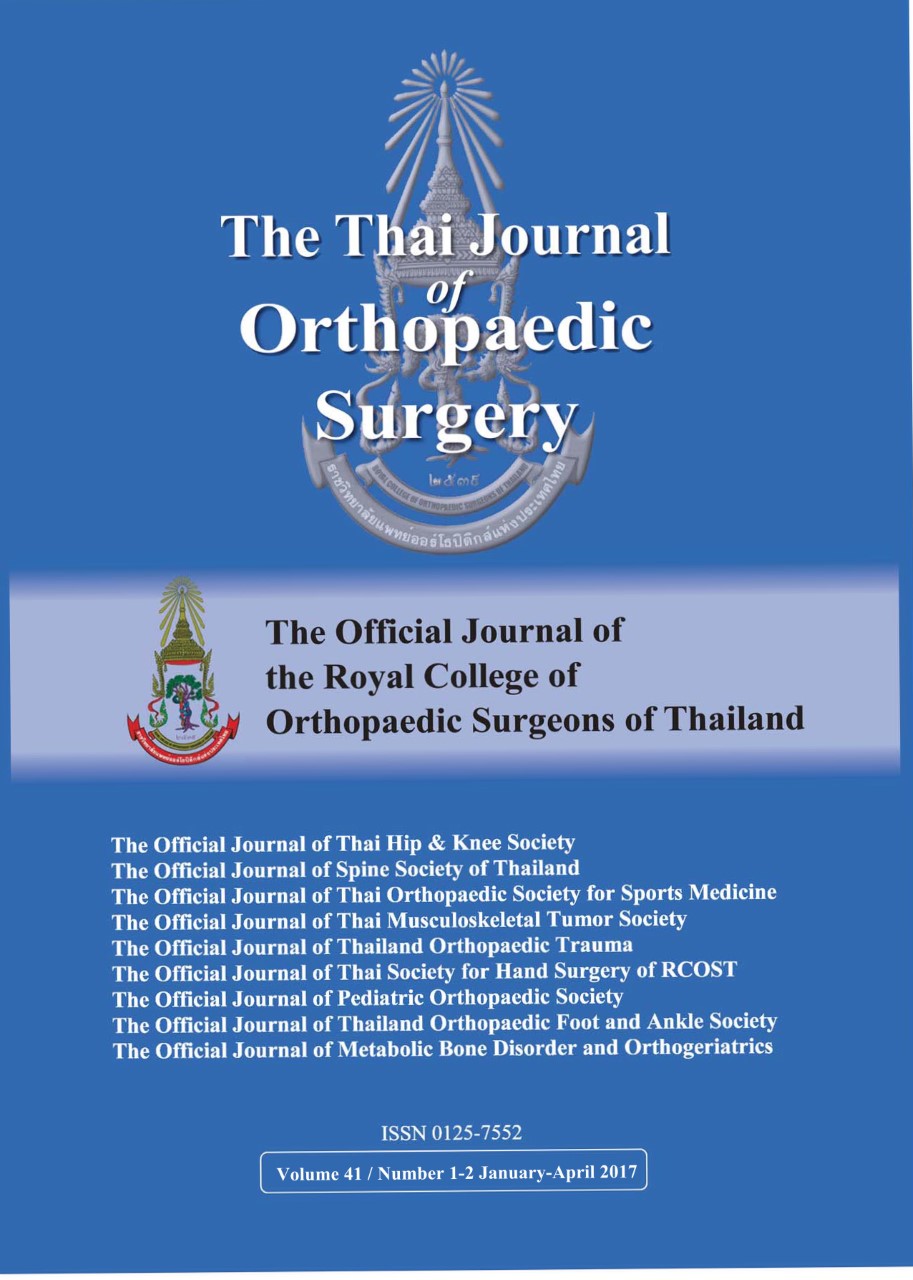Accuracy of clinical examination and magnetic resonance imaging in arthroscopic knee surgery
Main Article Content
Abstract
Background and objectives: Diagnosis in knee injuries consist of clinical examinations and magnetic resonance imaging (MRI). The accuracy of these methods are varied. We performed a retrospective study to seek the accuracy of clinical examination and magnetic resonance imaging in arthroscopic knee surgery.
Materials and methods: A total of 44 patients were selected for review. Data including sensitivity, specificity, accuracy, positive predictive value, and negative predictive value were calculated.
Results: Arthroscopic examination should be kept as standard. The Lachman test is the most sensitive test to determine ACL tears, showing a sensitivity of 83% (95% confidence interval 0.64-0.99). The pivot shift test is the most specific test, showing a specificity of 85% (95% confidence interval 0.68-0.96). The McMurray test is the most sensitive test to determine meniscus tears, showing a sensitivity of 87% (95% confidence interval 0.76-0.96). The Apley test is a more specific test, showing a specificity of 86% (95% confidence interval 0.72-0.96). MRI of ACL showed a sensitivity of 96% (95% confidence interval 0.86-0.99). MRI of medial meniscus is a more sensitive test to determine meniscus tears, showing a sensitivity of 97% (95% confidence interval 0.88-0.99), MRI of lateral meniscus showed a sensitivity of 93% (95% confidence interval 0.84-0.99).
Conclusion: The clinical examination is an important and accurate diagnostic modality for the evaluation of knee injury. MRI is a more accurate diagnostic modality than clinical examination. It should be used when there is an uncertain indication for surgery.
Article Details
References
2. Berfeld j, Ireland ML, Wojtys EM. Pinpointing the cause of acute knee pain. Patient care 1997; 31: 100-117.
3. Lerat JL, Moyen BL, Cladiere F, Besse JL, Abidi H. Knee instability after injury to the anterior cruciate ligament. Quantification of the Lachman test. J Bone Joint Surg Br. 2000;82:42–47.
4. Cimino F, Volk BS, Setter D. Anterior cruciate ligament injury: diagnosis, management, and prevention. Am Fam Physician. 2010;82:917–922.
5. Kocabey Y, Tetik O, Isbell WM, et al. The value of clinical examination versus magnetic resonance imaging in the diagnosis of meniscal tears and anterior cruciate ligament rupture. Arthroscopy 2004;20:696-700.
6. Makdissi M, Eriksson KO, Morris HG, et al. MRI-negative bucket-handle tears of the lateral meniscus in athletes: a case series. Knee Surg Sports Traumatol Arthrosc 2006;14:1012-6.
7. Oei EH, Nikken JJ, Verstijnen AC, et al. MR imaging of the menisci and cruciate ligaments: a systematic review. Radiology 2003;226:837-48.
8. De Smet AA, Mukherjee R.. Clinical, MRI, and arthroscopic findings associated with failure to diagnose a lateral meniscal tear on knee MRI. AJR Am J Roentgenol 2008;190:22-6.
9. De Smet AA, Graf BK.. Meniscal tears missed on MR imaging: relationship to meniscal tear patterns and anterior cruciate ligament tears. AJR Am J Roentgenol 1994;162:905-11.
10. Justice WW, Quinn SF. Error patterns in the MR imaging evaluation of menisci of the knee. Radiology1995;196:617-21.
11. Quinn SF, Brown TF. Meniscal tears diagnosed with MR imaging versus arthroscopy: how reliable a standard is arthroscopy? Radiology 1991;181:843-7.
12. Mesgarzadeh M, Moyer R, Leder DS, et al. MR imaging of the knee: expanded classification and pitfalls to interpretation of meniscal tears. Radiographics 1993;13:489-500.
13. Nikolic DK. Lateral meniscal tears and their evolution in acute injuries of the anterior cruciate ligament of the knee. Arthroscopic analysis. Knee Surg Sports Traumatol Arthrosc 1998;6:26-30.
14. Rayan F, Bhonsle S, Shukla DD. Clinical, MRI, and arthroscopic correlation in meniscal and anterior cruciate ligament injuries. Int Orthop 2009;33:129-32.
15. Torg JS, Conrad W, Kelen V. Clinical diagnosis of anterior cruciate ligament instability in the athlete. Am J Sports MED 1976;4:84-93.
16. Benjaminse A, Gokeler A, van de Schans CP. Clinical diagnosis of an anterior cruciated ligament rupture: a meta-analysis. J Orthop Sports Phys Ther 2006;36:267-88.
17. Bach BR Jr, Warren RF, Wickiewicz TL. The pivot shift phenomenon: result and description of a modified clinical test for anterior cruciate ligament insufficiency. Am J Sports Med 1988;16:571-6
18. Tanaka M, Vyas D, Moloney G , Bedi A, Pear AD, Musahl V. What does it take to have a high-grade pivot shift? Knee Surg Sports Traumatol Arthrosc 2012;20:737-42.
19. Steinbruck K, Wiehmann JC. Examination of the knee joint. The value of clinical finding in arthroscopic control. Z Orthop Ihre Grenzgeb 1988;126:289-95.
20. Sharifah MI, Lee CL, Suraya A, et al. Accuracy of MRI in the diagnosis of meniscal tears in patients with chronic ACL tears. Knee Surg Sports Traumatol Arthrosc 2015;23:826-30.
21. Esmaili Jah AA, Keyhani S, Zarei R, et al. Accuracy of MRI in comparison with clinical and arthroscopic findings in ligamentous and meniscal injuries of the knee. Acta Orthop Belg 2005;71:189-96
22. Chambers S, Cooney A, Caplan N, et al. The accuracy of magnetic resonance imaging (MRI) in detecting meniscal pathology. J R Nav Med Serv 2014;100:157-60.


